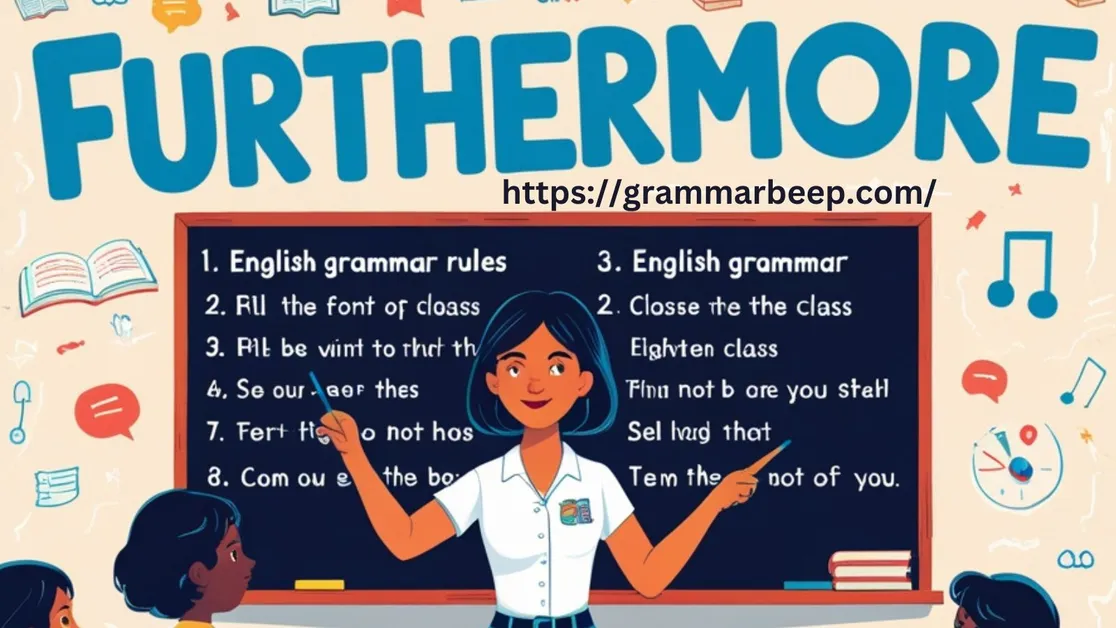20 Other Ways to Say “Furthermore” proves how powerful language becomes when you move beyond overused expressions. Using fresh synonyms for furthermore can make your writing feel polished, engaging, and natural — whether you’re crafting a business email, research paper, or casual blog. These versatile transition words for addition not only improve sentence flow but also help you emphasize a point more effectively. With the right phrases, you connect ideas smoothly, keep readers interested, and elevate your communication from ordinary to impactful.
Mastering these additive transition phrases means you can adjust tone and style effortlessly across any context. Whether you need formal transition phrases for academic writing or conversational transitions for everyday speech, this guide offers practical examples, usage tips, and context-rich scenarios. Each alternative brings its own nuance, allowing you to present supplementary information naturally and with purpose. By expanding your vocabulary, you strengthen your voice and make every word count.
Moreover
One of the most common formal alternatives to furthermore, moreover adds weight to your argument and shows that the next point is directly related to the preceding statement.
Example – Business Email:
Dear Emma,
The marketing team exceeded its quarterly goals. Moreover, the campaign generated a 35% increase in brand engagement.
Best regards,
Daniel
This transitional expression is ideal for academic writing transition words and professional documents where you want to strengthen a previous statement without sounding repetitive.
Additionally
Additionally is a polished and versatile phrase often used to introduce supplementary information. It works well in reports, research papers, and even day-to-day communication.
Example – Formal Report:
The software update resolved major security vulnerabilities. Additionally, it improved user interface speed by 40%.
It’s a clear choice for contexts requiring discourse markers in English and shows how you can connect related ideas seamlessly.
In Addition
Slightly more conversational than additionally, in addition is still considered formal and widely used in academic and professional settings. It’s one of the best sentence connectors examples to introduce extra details.
Example – Presentation:
The initiative has created new job opportunities. In addition, it’s attracted international investment.
This phrase works well when you want to highlight two related points and complement the prior information.
Also
Also is simple but effective. It’s one of the most flexible additive conjunctions, suitable for casual conversation and formal writing alike.
Example – Email:
Hi James,
I reviewed the project proposal. Also, I’ve attached the revised timeline for your approval.
Best,
Laura
Because of its simplicity, also fits naturally into sentences and helps show consistency in trends or ideas.
Plus
While plus is often seen as casual, it’s increasingly used in business and digital communication to introduce additional information in a friendly yet professional way.
Example – Internal Message:
We need to finalize the budget this week. Plus, we should prepare a presentation for investors.
It conveys an extra benefit or added value and adds a conversational tone to writing.
What’s More
This expression draws attention to the next statement and compounds or intensifies a statement you’ve already made. It’s particularly effective when presenting multiple advantages.
Example – Marketing Copy:
The platform is easy to use. What’s more, it offers free customer support 24/7.
It’s a great choice in contexts where you want to emphasize a point and make your argument more persuasive.
Check out this: 20 Other Ways to Say “Well Done”
As Well As
This phrase suggests that the two elements being connected are equally important, making it a powerful choice when you want to highlight significant information.
Example – Resume Sentence:
Skilled in financial forecasting as well as strategic planning.
It works well in both formal writing phrases and informal speech to connect related ideas naturally.
On Top of That
If you’re aiming for a friendly, conversational tone, on top of that is a great option. It indicates that the new information adds even more weight to the previous point.
Example – Casual Conversation:
The restaurant serves delicious food. On top of that, the staff is incredibly friendly.
This is a great example of informal linking words that make writing sound natural and engaging.
Likewise
Likewise is often used to show consistency in trends or continue a pattern of thought. It’s especially useful in comparative statements.
Example – Academic Essay:
The company’s first product was a huge success. Likewise, the second release surpassed all expectations.
It signals that the next point aligns with or mirrors the previous one — ideal when you need transitional expressions with logical flow.
More for you: 20 Other Ways to Say “Clear Communication”
Then Again
While then again can introduce a contrasting point, it’s also used to complement the prior information with a perspective that carries similar weight.
Example – Opinion Piece:
The proposal addresses key issues. Then again, it leaves room for improvement in execution.
It’s slightly more informal but adds a thoughtful nuance to your writing.
And
Perhaps the most common English conjunction, and might seem basic, but it’s incredibly effective for linking ideas and creating flow.
Example – Email:
Hi Mia,
I finished the report and sent it to the client.
Regards,
Oliver
It’s a staple of transition words list and is used universally in writing and speech.
Not to Mention
This phrase is particularly useful when you want to point out an obvious yet important detail that adds strength to your argument.
Example – Persuasive Paragraph:
The new product is affordable and reliable, not to mention environmentally friendly.
It works well in persuasive and narrative contexts where you want to drive home a key point.
For your interest: 20 Other Ways to Say “You Can Do It”
Besides
Besides signals that the following statement adds another layer to the argument or discussion. It’s a handy tool to introduce additional information casually or formally.
Example – Conversation:
I don’t feel like going out tonight. Besides, it’s raining heavily.
It often suggests that the added information reinforces a decision or opinion.
What’s Even Better
This phrase adds excitement and emphasis, often used in marketing, storytelling, or persuasive writing to compound a statement.
Example – Sales Pitch:
The software is fast and secure. What’s even better, it integrates with all major platforms.
It’s ideal for emphasizing the best feature or advantage.
Coupled With
Coupled with is a more formal phrase that suggests two ideas are connected and complement the prior information.
Example – Business Report:
High customer satisfaction, coupled with strong sales performance, indicates a positive trend.
This is excellent in analytical or academic writing where precision matters.
Similarly
When you want to draw parallels or show continuation of a thought, similarly is the perfect choice.
Example – Research Paper:
The northern region reported increased rainfall. Similarly, the southern area saw above-average precipitation.
It’s often used in academic writing transition words to build logical relationships.
Equally Important
This phrase highlights that the next point is just as significant as the one before, helping you highlight two related points with balance.
Example – Essay:
Reducing emissions is critical. Equally important, we must invest in renewable energy sources.
It’s an effective way to structure balanced arguments.
Apart from That
This informal phrase introduces a new piece of supplementary information without sounding too rigid.
Example – Conversation:
I’ve submitted the application. Apart from that, there’s nothing else pending.
It’s useful in casual contexts or light business communication.
You might also like: 20 Other Ways to Say “That’s Cool”
Beyond That
Beyond that suggests that you’re moving past the initial point to additive nature of information that builds depth.
Example – Business Proposal:
The company plans to expand into new markets. Beyond that, it aims to diversify its product portfolio.
It signals progression and forward-thinking.
In the Same Way
This phrase is excellent when you want to show consistency in trends or behaviors between two related ideas.
Example – Academic Article:
The policy improved urban mobility. In the same way, it reduced traffic congestion significantly.
It’s widely used in analytical writing to draw parallels effectively.
Synonyms for “Furthermore” – Quick Reference Table
| Synonym | Tone | Best Used In |
|---|---|---|
| Moreover | Formal | Academic writing, research papers |
| Additionally | Formal | Reports, essays |
| In addition | Neutral | Presentations, professional writing |
| Also | Neutral | Emails, general writing |
| Plus | Casual | Conversations, marketing copy |
| What’s more | Neutral | Marketing, persuasive writing |
| As well as | Neutral | CVs, professional profiles |
| On top of that | Casual | Informal speech, blogs |
| Likewise | Formal | Research, analytical writing |
| Then again | Neutral | Opinion pieces, informal essays |
| And | Universal | All writing types |
| Not to mention | Neutral | Persuasive writing |
| Besides | Neutral | Conversations, blogs |
| What’s even better | Casual | Advertising, pitches |
| Coupled with | Formal | Reports, data analysis |
| Similarly | Formal | Research papers, academic essays |
| Equally important | Formal | Arguments, academic writing |
| Apart from that | Casual | Conversations, internal messages |
| Beyond that | Formal | Business proposals, strategies |
| In the same way | Formal | Analytical writing, essays |
FAQs
Can I use “furthermore” in casual conversations?
Yes, but it can sound too formal, so choose casual alternatives to furthermore like “plus” or “on top of that.”
Are these alternatives suitable for academic writing?
Absolutely, many formal transition phrases like “moreover” and “in addition” are widely used in research papers and essays.
Which synonym is best for emails?
Phrases such as “also” and “additionally” work well in business writing transition phrases for emails and reports.
Do these alternatives change the sentence meaning?
No, most expressions to add more information carry the same meaning but offer variety and tone flexibility.
Can I combine more than one transition in a paragraph?
Yes, mixing different additive conjunctions makes your writing sound more natural and avoids repetition.
Conclusion
20 Other Ways to Say “Furthermore” shows how small word choices can transform your writing. Using linking words in English keeps ideas connected and sentences clear. It helps you highlight significant information and guide your readers smoothly from one thought to the next.
These powerful expressions to add more information work in essays, presentations, or daily conversations. They give your writing variety and flow. Once you master these words similar to furthermore, you’ll communicate with more confidence and make your messages more impactful.

Zoey Alba is an experienced blogger and language enthusiast with a passion for helping readers master the art of grammar. With years of expertise in writing, editing, and content creation, Zoey shares practical tips and insightful advice to make grammar accessible for all. When she’s not writing, Zoey enjoys reading, learning new languages, and inspiring others to write with confidence.
